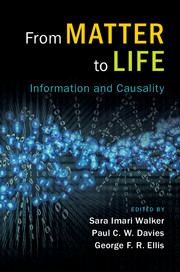Book contents
- Frontmatter
- Contents
- About the authors
- 1 Introduction
- Part I Physics and Life
- Part II Bio from Bit
- Part III Life's Hidden Information
- 8 Cryptographic Nature
- 9 Noise and Function
- 10 The Many Faces of State Space Compression
- 11 Causality, Information, and Biological Computation: An Algorithmic Software Approach to Life, Disease, and the Immune System
- Part IV Complexity and Causality
- Part V From Matter to Mind
- Index
9 - Noise and Function
from Part III - Life's Hidden Information
Published online by Cambridge University Press: 02 March 2017
- Frontmatter
- Contents
- About the authors
- 1 Introduction
- Part I Physics and Life
- Part II Bio from Bit
- Part III Life's Hidden Information
- 8 Cryptographic Nature
- 9 Noise and Function
- 10 The Many Faces of State Space Compression
- 11 Causality, Information, and Biological Computation: An Algorithmic Software Approach to Life, Disease, and the Immune System
- Part IV Complexity and Causality
- Part V From Matter to Mind
- Index
Summary
We are surrounded by noise. The controlled explosions of internal combustion engines combine with the roar of rubber on asphalt to create the drone of road and highway traffic. Weed-whackers, lawn mowers, and leaf blowers can turn sunny suburban summer days into a buzzing confusion. Indeed, the entire universe is filled with the faint din that is the cosmic microwave background (CMB) radiation, leftover electromagnetic radiation from the Big Bang. The CMB was discovered when Penzias and Wilson (1965) went looking for the source of annoying hiss plaguing their new radio telescope, hiss that threatened to obscure signals from distant stars and galaxies. Noise seems to be entirely destructive, thus something to be eliminated, if possible.
Noise can be beneficial, however, in at least two ways. One is familiar, the other paradoxical and far less well known. The familiar way is simply as a source of variety. For example, genes undergo random mutation from processes both external to the organism (e.g., cosmic rays) and internal (Dobrindt and Hacker, 2001). This genotypic variation is the source of heritable variation in phenotype, which is of course essential for the process of natural selection (Wagner, 2014). Phenotype can even vary within isogenic populations due to variation in gene expression (Fraser and Kaern, 2009). This phenotypic noise is thought to provide an evolutionary advantage for some microorganisms, as it increases the chance that some will survive under stressful conditions. The CMB noise, though destructive from the standpoint of the users of radio telescopes, plays a constructive role in generating the tiny variations in energy density in the early universe that are the seeds of structure formation. The random fluctuations we call noise gave rise to stars and galaxies and galactic clusters. This much is familiar, at least to those working in the relevant areas of biology or astrophysics.
Considerably less familiar is the role that noise can play in nonlinear systems, in particular systems with one or more thresholds, points at which small differences in input give rise to disproportionate differences in output. Converting an analog signal into a digital signal involves sampling the signal at regular intervals and writing down a digital approximation of the amplitude at each point.
- Type
- Chapter
- Information
- From Matter to LifeInformation and Causality, pp. 174 - 198Publisher: Cambridge University PressPrint publication year: 2017
- 2
- Cited by



